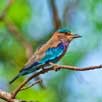National parks
© Copyright 2025-26 by GTI Travels Pvt. Ltd.
Sundarbans is one of the largest assortments of numerous deltas. Located in the district of South 24 Paragana in the state of West Bengal, the park is one of the largest National Parks in India with around 1330 sq km as its land area.

The largest mangrove forest in the world, the Sundarbans National Park is known for its distinctive landscape and the rich flora and fauna. Designated as the UNESCO World Heritage site, the forest of the Sundarbans is one of the largest assortments of numerous deltas. Located in the district of South 24 Paragana in the state of West Bengal, the park is one of the largest National Parks in India with around 1330 sq km as its land area. The park comprises of 54 small islands formed by crisscrossing of the various river channels which are the tributaries of the river Ganga.

The ecologically unique landscape with the abundance of the wildlife in the forest in the coastal region of the Bay of Bengal is one of the most visited National Parks in India and most favorite among the wildlife researchers and core wildlife enthusiasts. With having around 55 mammal species, 55 reptile species and more than 250 bird species, the park has everything to offer to tourists visited here embarked on an adventurous wildlife holiday. The gorgeous view of the lush greenery constituted primarily by the Sundari tree which inspired the name of the Sundarbans forest and the sighting of the wild animals in the wilderness far from the cities will be a memorable experience for any Wildlife and Nature lover visitors.

In the year of 1973, the forest of Sundarbans had been designated as the Tiger Reserve Forest due to the presence of a good number of Tigers in the forest. Later in the year of 1977, the forest is declared as the wildlife sanctuary due to the abundance of the numerous other species of wild animals other than the tigers and the richness of the unique flora of the land. The tourism activities increased a lot after being it a wildlife sanctuary to explore the unique flora and fauna of the forest. As the popularity of the forest increased, the wildlife sanctuary is finally given the status of the National Park of India in the year of 1984 and after three years, in the year 1987, the park was recognized as the UNESCO World Heritage Site.

The Sundarbans National Park is known for having the most dangerous tigers which are famous for attacking humans and known as the man-eater tigers. The park is the natural habitat for more than 400 tigers along with other wild animals like Fishing Cat, Leopard, Wild Boar, Macaques, Indian Grey Mongoose, Jungle Cat, Fox, Flying Fox, Pangolin, Barking Deer, Spotted Deer, Chital, etc. The Royal Bengal Tigers of this park possesses the amazing skill of swimming in the river having the saline waters. One can easily spot the tigers and other wild animals roaming and sunbathing on the banks of the river during the winter season.

Unlike other most of the National Parks in India, the Sundarbans National Park is open throughout the year for the Boat Safari, but the Boat safari during the monsoon season can be dangerous as the water level of the river is very high due to the rains. So, one should avoid visiting the park during the monsoon season, especially tourists with children and family. The best time to visit the park is considered from September to March as the weather is pleasant during these days and the chances of the sighting of the wildlife are higher. The temperature and humidity are very high in the summer season so one should avoid visiting the park in this season.